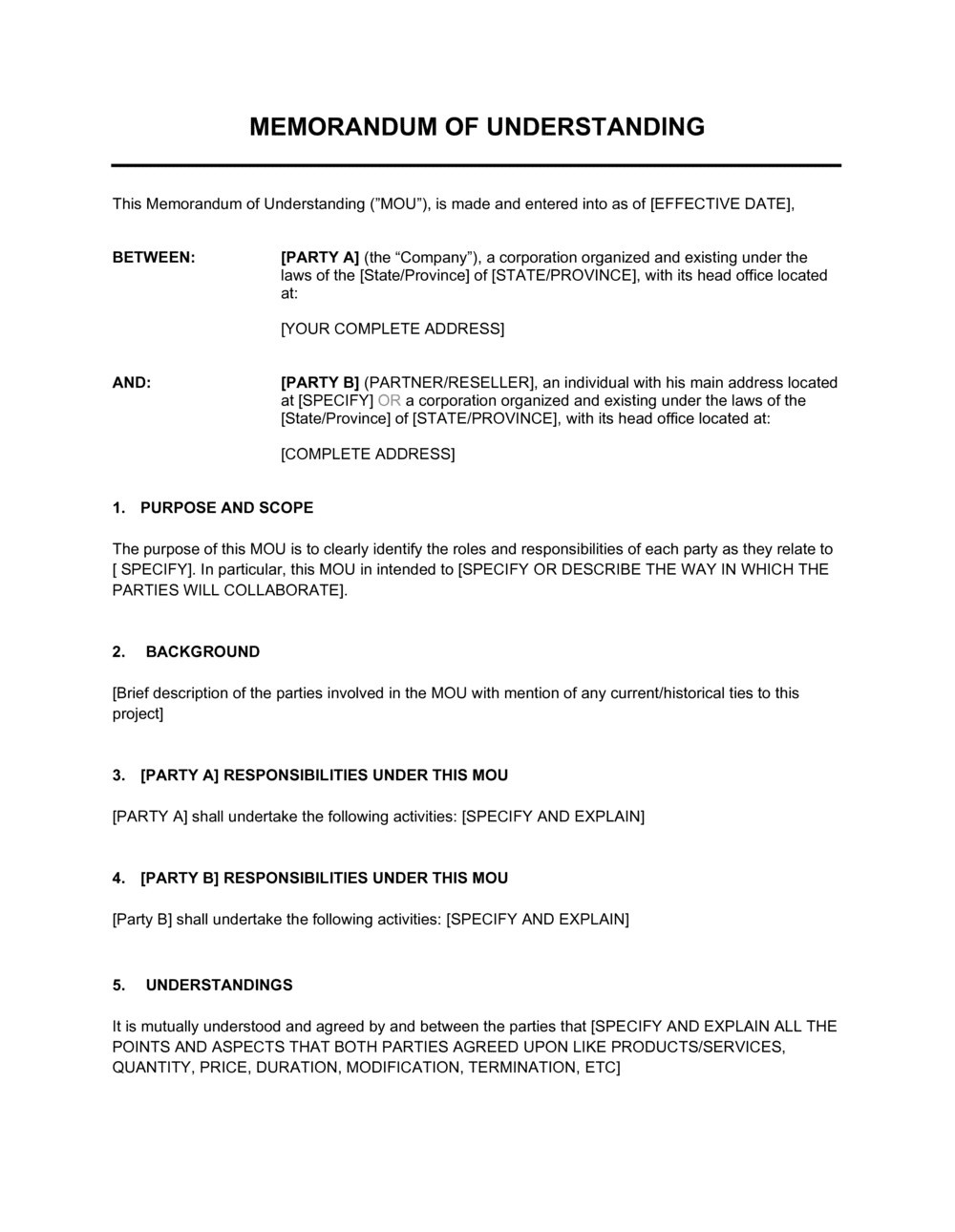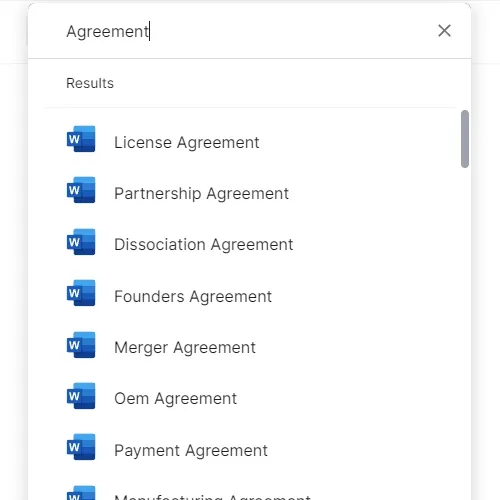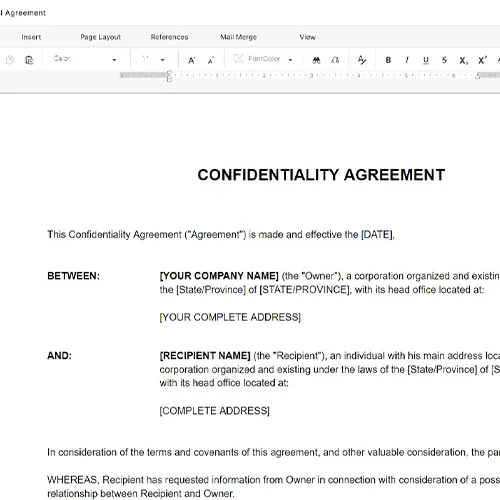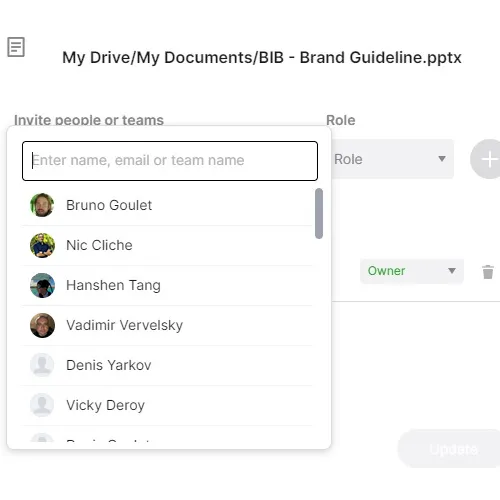Memorandum of Understanding Template

Crafting a Memorandum of Understanding (MOU) to Formalize Business Relationships
A Memorandum of Understanding (MOU) is an essential document used to outline the preliminary terms of a partnership or agreement between parties before finalizing a formal contract. While it is generally non-binding, an MOU clarifies mutual expectations, establishes a foundation of trust, and sets the stage for future collaboration. Whether you’re entering into a joint venture, partnership, or another business arrangement, a detailed MOU helps ensure both parties are aligned and committed to shared goals.
In this guide, we’ll walk through the critical components of an MOU, explain the benefits it offers, and show you how to use a template to create a comprehensive, professional document that paves the way for a successful business relationship.
Understanding the Memorandum of Understanding Template
An MOU template offers a structured framework that helps you outline the terms, responsibilities, and goals of a business arrangement. A well-constructed MOU includes specific sections to define each party’s role, responsibilities, and intentions. Standard sections in an MOU template often include:
- Introduction and Purpose
- Parties Involved
- Objectives and Scope
- Responsibilities and Obligations
- Duration and Termination
- Confidentiality and Data Sharing
- Dispute Resolution
- Signatures and Approvals
Using a template from Business in a Box ensures that you cover all essential elements, providing clarity and professionalism while simplifying the document creation process.
Why an MOU is Essential for Business Relationships
A Memorandum of Understanding provides a roadmap for the collaborative efforts of each party and establishes a mutual understanding of expectations. Here’s how a well-structured MOU supports business success:
- Clarifies Goals and Objectives: An MOU allows both parties to document their intentions and specific goals, ensuring everyone is aligned on the purpose and expected outcomes of the collaboration.
- Formalizes Roles and Responsibilities: Defining each party’s responsibilities prevents confusion and misunderstandings. With clear expectations documented, both parties can work more effectively and maintain accountability.
- Reduces the Risk of Disputes: An MOU provides a reference point for resolving misunderstandings or disagreements by clarifying each party’s intentions. A well-drafted MOU outlines a clear path for dispute resolution, reducing the likelihood of conflicts.
- Builds Trust and Commitment: Creating an MOU fosters trust by demonstrating each party’s commitment to the agreement. This foundation of trust can strengthen the relationship and pave the way for a more formal contract in the future.
Business in a Box offers a customizable MOU template that guides you through each section, ensuring all critical aspects of the agreement are addressed clearly and professionally.
Key Sections of a Memorandum of Understanding Template
Choosing the right template is essential for creating an MOU that is cohesive, detailed, and legally sound. Here’s a breakdown of the essential sections of an MOU and strategies for making each one effective.
1. Introduction and Purpose
The introduction provides a high-level overview of the MOU, establishing the document’s purpose and clarifying the nature of the relationship. This section sets the stage for the collaboration and gives context to the terms that follow.
Key elements to include:
- Purpose of the MOU: Clearly state why the document is being created and what the agreement aims to achieve.
- Brief Description of the Relationship: Describe the type of arrangement or partnership the MOU covers, whether it’s a joint venture, research collaboration, or partnership.
- Background Information: If relevant, provide a brief history or context about how the collaboration came to be.
A strong introduction provides clarity and context, ensuring all readers understand the intent and scope of the MOU from the start.
2. Parties Involved
This section identifies all parties entering into the agreement, ensuring that each organization or individual’s role in the MOU is explicitly stated. This clarity avoids confusion and formalizes the participation of each entity in the document.
When detailing the parties involved, include:
- Full Legal Names: Provide the full legal names of each party, ensuring accuracy and professionalism.
- Contact Information: List contact details, including mailing addresses, phone numbers, and emails, for each organization or individual involved.
- Representatives: If applicable, specify the individuals authorized to sign or represent each party in this agreement.
The parties involved section ensures transparency, formalizing the involvement of each entity in the agreement and creating a point of reference for future interactions.
3. Objectives and Scope
The objectives and scope section outlines the goals and expectations of the collaboration. This section provides a detailed description of what each party intends to accomplish, along with any specific deliverables or milestones.
In structuring this section, include:
- Overall Goals: Define the main objectives of the MOU, such as product development, research, or strategic alignment.
- Scope of Activities: List the specific activities or projects each party is responsible for within the collaboration.
- Expected Outcomes: Describe the anticipated results or milestones the collaboration aims to achieve.
The objectives and scope section provides direction for the collaboration, setting clear expectations and defining the intended outcomes of the agreement.
4. Responsibilities and Obligations
This section clarifies the responsibilities and obligations of each party involved in the agreement. By detailing who is accountable for specific tasks or roles, you help ensure that both parties understand their commitments and avoid overlaps.
Consider including:
- Detailed Responsibilities: Outline specific tasks each party is responsible for, ensuring clarity on individual and shared obligations.
- Resource Allocation: Specify any resources, personnel, or funding that each party will contribute.
- Reporting Requirements: If applicable, outline any reporting responsibilities, including frequency and format, to maintain transparency.
This section helps manage expectations, ensuring that each party’s role in the collaboration is clearly defined and documented.
5. Duration and Termination
The duration and termination section specifies the length of the MOU, as well as any conditions for early termination. Establishing these terms ensures both parties know the timeframe of the agreement and what conditions might lead to its end.
Key points to cover:
- Effective Date: Clearly state when the MOU will come into effect.
- Duration: Specify the expected timeframe for the agreement, whether it’s for a fixed period, ongoing, or project-based.
- Termination Conditions: Outline the circumstances under which either party can terminate the agreement, such as breach of terms, mutual agreement, or the completion of certain milestones.
By defining the duration and termination terms, you create a clear framework for the MOU’s lifecycle, providing both parties with confidence in their commitment and expectations.
6. Confidentiality and Data Sharing
Confidentiality and data sharing clauses protect sensitive information that may be shared during the collaboration. These clauses prevent unauthorized disclosure of proprietary information and ensure both parties can trust that shared data will be handled appropriately.
This section should include:
- Confidentiality Agreement: Outline any specific confidentiality requirements, including what information is protected and any exceptions.
- Data Sharing Protocols: Define how data will be shared, including methods for data transfer, storage, and access.
- Duration of Confidentiality: Specify how long confidentiality obligations will last, even after the MOU ends, if applicable.
A comprehensive confidentiality and data-sharing clause safeguards both parties’ proprietary information, creating a secure foundation for collaboration.
7. Dispute Resolution
This section establishes a method for resolving disputes, should any disagreements arise during the course of the agreement. By outlining a clear dispute resolution process, both parties can avoid prolonged conflicts and ensure issues are addressed fairly and efficiently.
When drafting this section, consider including:
- Preferred Resolution Method: Specify whether disputes will be handled through negotiation, mediation, arbitration, or legal proceedings.
- Governing Law: Define which jurisdiction’s laws will govern the MOU and any disputes that may arise.
- Arbitration Details: If arbitration is chosen, include specifics about the process, such as selecting an arbitrator and the rules that will govern the proceedings.
A well-defined dispute resolution clause provides a fair, structured approach to addressing disagreements, helping both parties resolve issues amicably.
8. Signatures and Approvals
The signatures and approvals section formalizes the agreement, confirming that each party agrees to the terms outlined in the MOU. Signatures signify commitment and provide a legally recognized acknowledgment of the MOU.
Include the following in this section:
- Authorized Signatories: Ensure that the individuals signing the document have the authority to represent their respective organizations.
- Signatures and Dates: Include spaces for each party’s signature and the date, making the document official and binding.
- Additional Witnesses: If required, add a line for witnesses to sign, further validating the agreement.
This section finalizes the MOU, marking the official beginning of the business relationship and providing a record of each party’s commitment.
How Business in a Box Simplifies MOU Creation
Creating a comprehensive Memorandum of Understanding from scratch can be challenging, especially when you need to cover all necessary details and ensure legal compliance. Business in a Box’s MOU templates provide a structured, step-by-step approach that simplifies the process, helping you produce a professional and effective document.
With Business in a Box’s MOU templates, you gain access to:
- Time Savings - Pre-structured templates cover all critical areas, enabling you to create a detailed MOU efficiently, saving time and effort.
- Customizable Design - Tailor each template to reflect the specific terms and requirements of your agreement, making it uniquely suited to your collaboration.
- Enhanced Professionalism - A polished, well-organized MOU demonstrates your commitment to the partnership and ensures both parties understand their roles and responsibilities.
- Compliance and Legal Assurance - Crafted with best practices in mind, Business in a Box templates help ensure your MOU meets professional and legal standards, minimizing the risk of future disputes.
Supporting Documents for a Comprehensive MOU
An effective MOU often benefits from additional supporting documents that provide further structure and clarity. Business in a Box offers templates for various documents that complement an MOU and support a successful collaboration:
- Non-Disclosure Agreement (NDA) Protects sensitive information shared between parties during negotiations and throughout the partnership. An NDA ensures that proprietary information, trade secrets, and other confidential data are safeguarded, fostering trust between parties. Explore our Non-Disclosure Agreement templates.
- Project Plan Provides an outline of the proposed project, detailing key milestones, timelines, and resource allocations. A project plan offers a clear roadmap for both parties, ensuring alignment on goals, deadlines, and resources. Explore our Project Plan templates.
- Communications Plan Establishes protocols for regular communication and reporting, ensuring transparency and accountability throughout the collaboration. A well-defined communications plan enables both parties to stay informed, address issues promptly, and maintain open lines of communication. Explore our Communications Plan templates.
Integrating these additional documents with your MOU provides a comprehensive foundation for your collaboration, enhancing clarity, accountability, and security.
Getting Started with Business in a Box
Using Business in a Box’s MOU templates ensures that your agreement covers every essential detail, setting the foundation for a successful and transparent partnership. With clearly defined roles, responsibilities, and expectations, both parties can focus on achieving shared objectives without confusion or misalignment.
To get started:
- Outline Key Terms and Goals - Define the core goals of your partnership, the contributions of each party, and any specific roles or responsibilities.
- Customize the Template - Use the MOU template from Business in a Box to structure your document, tailoring each section to reflect the unique aspects of your collaboration.
- Add Supporting Documents - Attach an NDA, Project Plan, and Communications Plan to your MOU for additional clarity and security.
- Review and Approve - Ensure both parties review the MOU and any supporting documents, making necessary adjustments and confirming all terms are clearly understood.
- Finalize and Sign - With all terms agreed upon, finalize the MOU with authorized signatures from each party, marking the official start of your business relationship.
Final Thoughts
A well-structured Memorandum of Understanding sets the foundation for a successful business relationship by establishing trust, clarifying expectations, and fostering collaboration. By outlining roles, responsibilities, and mutual goals, an MOU helps prevent misunderstandings and ensures a strong start to your partnership.
Business in a Box’s extensive library of templates, including the MOU, NDA, Project Plan, and Communications Plan, provides all the tools you need to establish a clear, legally sound framework for your collaboration. With these resources, you can focus on driving success and achieving shared objectives while maintaining professionalism and transparency.
Ready to get started? Explore our Memorandum of Understanding template and discover how Business in a Box can simplify your document creation, ensuring every aspect of your business relationship is clearly defined and protected.
Reviewed on

Crafting a Memorandum of Understanding (MOU) to Formalize Business Relationships
A Memorandum of Understanding (MOU) is an essential document used to outline the preliminary terms of a partnership or agreement between parties before finalizing a formal contract. While it is generally non-binding, an MOU clarifies mutual expectations, establishes a foundation of trust, and sets the stage for future collaboration. Whether you’re entering into a joint venture, partnership, or another business arrangement, a detailed MOU helps ensure both parties are aligned and committed to shared goals.
In this guide, we’ll walk through the critical components of an MOU, explain the benefits it offers, and show you how to use a template to create a comprehensive, professional document that paves the way for a successful business relationship.
Understanding the Memorandum of Understanding Template
An MOU template offers a structured framework that helps you outline the terms, responsibilities, and goals of a business arrangement. A well-constructed MOU includes specific sections to define each party’s role, responsibilities, and intentions. Standard sections in an MOU template often include:
- Introduction and Purpose
- Parties Involved
- Objectives and Scope
- Responsibilities and Obligations
- Duration and Termination
- Confidentiality and Data Sharing
- Dispute Resolution
- Signatures and Approvals
Using a template from Business in a Box ensures that you cover all essential elements, providing clarity and professionalism while simplifying the document creation process.
Why an MOU is Essential for Business Relationships
A Memorandum of Understanding provides a roadmap for the collaborative efforts of each party and establishes a mutual understanding of expectations. Here’s how a well-structured MOU supports business success:
- Clarifies Goals and Objectives: An MOU allows both parties to document their intentions and specific goals, ensuring everyone is aligned on the purpose and expected outcomes of the collaboration.
- Formalizes Roles and Responsibilities: Defining each party’s responsibilities prevents confusion and misunderstandings. With clear expectations documented, both parties can work more effectively and maintain accountability.
- Reduces the Risk of Disputes: An MOU provides a reference point for resolving misunderstandings or disagreements by clarifying each party’s intentions. A well-drafted MOU outlines a clear path for dispute resolution, reducing the likelihood of conflicts.
- Builds Trust and Commitment: Creating an MOU fosters trust by demonstrating each party’s commitment to the agreement. This foundation of trust can strengthen the relationship and pave the way for a more formal contract in the future.
Business in a Box offers a customizable MOU template that guides you through each section, ensuring all critical aspects of the agreement are addressed clearly and professionally.
Key Sections of a Memorandum of Understanding Template
Choosing the right template is essential for creating an MOU that is cohesive, detailed, and legally sound. Here’s a breakdown of the essential sections of an MOU and strategies for making each one effective.
1. Introduction and Purpose
The introduction provides a high-level overview of the MOU, establishing the document’s purpose and clarifying the nature of the relationship. This section sets the stage for the collaboration and gives context to the terms that follow.
Key elements to include:
- Purpose of the MOU: Clearly state why the document is being created and what the agreement aims to achieve.
- Brief Description of the Relationship: Describe the type of arrangement or partnership the MOU covers, whether it’s a joint venture, research collaboration, or partnership.
- Background Information: If relevant, provide a brief history or context about how the collaboration came to be.
A strong introduction provides clarity and context, ensuring all readers understand the intent and scope of the MOU from the start.
2. Parties Involved
This section identifies all parties entering into the agreement, ensuring that each organization or individual’s role in the MOU is explicitly stated. This clarity avoids confusion and formalizes the participation of each entity in the document.
When detailing the parties involved, include:
- Full Legal Names: Provide the full legal names of each party, ensuring accuracy and professionalism.
- Contact Information: List contact details, including mailing addresses, phone numbers, and emails, for each organization or individual involved.
- Representatives: If applicable, specify the individuals authorized to sign or represent each party in this agreement.
The parties involved section ensures transparency, formalizing the involvement of each entity in the agreement and creating a point of reference for future interactions.
3. Objectives and Scope
The objectives and scope section outlines the goals and expectations of the collaboration. This section provides a detailed description of what each party intends to accomplish, along with any specific deliverables or milestones.
In structuring this section, include:
- Overall Goals: Define the main objectives of the MOU, such as product development, research, or strategic alignment.
- Scope of Activities: List the specific activities or projects each party is responsible for within the collaboration.
- Expected Outcomes: Describe the anticipated results or milestones the collaboration aims to achieve.
The objectives and scope section provides direction for the collaboration, setting clear expectations and defining the intended outcomes of the agreement.
4. Responsibilities and Obligations
This section clarifies the responsibilities and obligations of each party involved in the agreement. By detailing who is accountable for specific tasks or roles, you help ensure that both parties understand their commitments and avoid overlaps.
Consider including:
- Detailed Responsibilities: Outline specific tasks each party is responsible for, ensuring clarity on individual and shared obligations.
- Resource Allocation: Specify any resources, personnel, or funding that each party will contribute.
- Reporting Requirements: If applicable, outline any reporting responsibilities, including frequency and format, to maintain transparency.
This section helps manage expectations, ensuring that each party’s role in the collaboration is clearly defined and documented.
5. Duration and Termination
The duration and termination section specifies the length of the MOU, as well as any conditions for early termination. Establishing these terms ensures both parties know the timeframe of the agreement and what conditions might lead to its end.
Key points to cover:
- Effective Date: Clearly state when the MOU will come into effect.
- Duration: Specify the expected timeframe for the agreement, whether it’s for a fixed period, ongoing, or project-based.
- Termination Conditions: Outline the circumstances under which either party can terminate the agreement, such as breach of terms, mutual agreement, or the completion of certain milestones.
By defining the duration and termination terms, you create a clear framework for the MOU’s lifecycle, providing both parties with confidence in their commitment and expectations.
6. Confidentiality and Data Sharing
Confidentiality and data sharing clauses protect sensitive information that may be shared during the collaboration. These clauses prevent unauthorized disclosure of proprietary information and ensure both parties can trust that shared data will be handled appropriately.
This section should include:
- Confidentiality Agreement: Outline any specific confidentiality requirements, including what information is protected and any exceptions.
- Data Sharing Protocols: Define how data will be shared, including methods for data transfer, storage, and access.
- Duration of Confidentiality: Specify how long confidentiality obligations will last, even after the MOU ends, if applicable.
A comprehensive confidentiality and data-sharing clause safeguards both parties’ proprietary information, creating a secure foundation for collaboration.
7. Dispute Resolution
This section establishes a method for resolving disputes, should any disagreements arise during the course of the agreement. By outlining a clear dispute resolution process, both parties can avoid prolonged conflicts and ensure issues are addressed fairly and efficiently.
When drafting this section, consider including:
- Preferred Resolution Method: Specify whether disputes will be handled through negotiation, mediation, arbitration, or legal proceedings.
- Governing Law: Define which jurisdiction’s laws will govern the MOU and any disputes that may arise.
- Arbitration Details: If arbitration is chosen, include specifics about the process, such as selecting an arbitrator and the rules that will govern the proceedings.
A well-defined dispute resolution clause provides a fair, structured approach to addressing disagreements, helping both parties resolve issues amicably.
8. Signatures and Approvals
The signatures and approvals section formalizes the agreement, confirming that each party agrees to the terms outlined in the MOU. Signatures signify commitment and provide a legally recognized acknowledgment of the MOU.
Include the following in this section:
- Authorized Signatories: Ensure that the individuals signing the document have the authority to represent their respective organizations.
- Signatures and Dates: Include spaces for each party’s signature and the date, making the document official and binding.
- Additional Witnesses: If required, add a line for witnesses to sign, further validating the agreement.
This section finalizes the MOU, marking the official beginning of the business relationship and providing a record of each party’s commitment.
How Business in a Box Simplifies MOU Creation
Creating a comprehensive Memorandum of Understanding from scratch can be challenging, especially when you need to cover all necessary details and ensure legal compliance. Business in a Box’s MOU templates provide a structured, step-by-step approach that simplifies the process, helping you produce a professional and effective document.
With Business in a Box’s MOU templates, you gain access to:
- Time Savings - Pre-structured templates cover all critical areas, enabling you to create a detailed MOU efficiently, saving time and effort.
- Customizable Design - Tailor each template to reflect the specific terms and requirements of your agreement, making it uniquely suited to your collaboration.
- Enhanced Professionalism - A polished, well-organized MOU demonstrates your commitment to the partnership and ensures both parties understand their roles and responsibilities.
- Compliance and Legal Assurance - Crafted with best practices in mind, Business in a Box templates help ensure your MOU meets professional and legal standards, minimizing the risk of future disputes.
Supporting Documents for a Comprehensive MOU
An effective MOU often benefits from additional supporting documents that provide further structure and clarity. Business in a Box offers templates for various documents that complement an MOU and support a successful collaboration:
- Non-Disclosure Agreement (NDA) Protects sensitive information shared between parties during negotiations and throughout the partnership. An NDA ensures that proprietary information, trade secrets, and other confidential data are safeguarded, fostering trust between parties. Explore our Non-Disclosure Agreement templates.
- Project Plan Provides an outline of the proposed project, detailing key milestones, timelines, and resource allocations. A project plan offers a clear roadmap for both parties, ensuring alignment on goals, deadlines, and resources. Explore our Project Plan templates.
- Communications Plan Establishes protocols for regular communication and reporting, ensuring transparency and accountability throughout the collaboration. A well-defined communications plan enables both parties to stay informed, address issues promptly, and maintain open lines of communication. Explore our Communications Plan templates.
Integrating these additional documents with your MOU provides a comprehensive foundation for your collaboration, enhancing clarity, accountability, and security.
Getting Started with Business in a Box
Using Business in a Box’s MOU templates ensures that your agreement covers every essential detail, setting the foundation for a successful and transparent partnership. With clearly defined roles, responsibilities, and expectations, both parties can focus on achieving shared objectives without confusion or misalignment.
To get started:
- Outline Key Terms and Goals - Define the core goals of your partnership, the contributions of each party, and any specific roles or responsibilities.
- Customize the Template - Use the MOU template from Business in a Box to structure your document, tailoring each section to reflect the unique aspects of your collaboration.
- Add Supporting Documents - Attach an NDA, Project Plan, and Communications Plan to your MOU for additional clarity and security.
- Review and Approve - Ensure both parties review the MOU and any supporting documents, making necessary adjustments and confirming all terms are clearly understood.
- Finalize and Sign - With all terms agreed upon, finalize the MOU with authorized signatures from each party, marking the official start of your business relationship.
Final Thoughts
A well-structured Memorandum of Understanding sets the foundation for a successful business relationship by establishing trust, clarifying expectations, and fostering collaboration. By outlining roles, responsibilities, and mutual goals, an MOU helps prevent misunderstandings and ensures a strong start to your partnership.
Business in a Box’s extensive library of templates, including the MOU, NDA, Project Plan, and Communications Plan, provides all the tools you need to establish a clear, legally sound framework for your collaboration. With these resources, you can focus on driving success and achieving shared objectives while maintaining professionalism and transparency.
Ready to get started? Explore our Memorandum of Understanding template and discover how Business in a Box can simplify your document creation, ensuring every aspect of your business relationship is clearly defined and protected.
Easily Create Any Business Document You Need in Minutes.

Download or open template
Access over 3,000+ business and legal templates for any business task, project or initiative.

Edit and fill in the blanks
Customize your ready-made business document template and save it in the cloud.

Save, Share, Export, or Sign
Share your files and folders with your team. Create a space of seamless collaboration.


